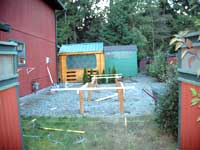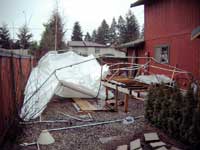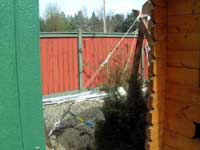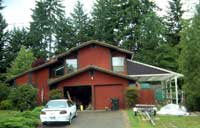Saga of the Boat Shed
by Barrett Faneuf
The adventure begins
One of the best things about my house is the great side yard.
It practically screamed to have a boat built in it. Originally
intended as RV parking, a previous owner had gravelled the area
for parking his tractor trailer engine. The overall space is
over 35 feet long, 20+ feet wide, and basically empty of troubling
things like septic fields or water lines. It has an 8-foot wide
gate at the road side. After determining with John Welsford
what shed size Nighean would need, I set to work. Strongback
posts were sunk, and the beginnings of a workspace were laid
out.
 |
The Building
Site
It looks so innocent... now.
(click to enlarge) |
The Tarp Shed
It was SUCH a good idea. I needed about 30 x
16 feet for Nighean, with 10 feet overhead to turn her. After
a good deal of web-surfing, I found the answer. A nice gambrel-roof
tarp shed kit, the type where the supplier sends the tarp, fittings,
etc, and the buyer buys metal electrical conduit and sets it
up. The whole shebang cost less than $1000, which was just dandy.
If I had all things in life, I would add a permanent addition
to the house, but that's pretty pricey and I decide to use the
tarp shed for now, and upgrade later when funds are more available.
I had the tarp shed set up right on time for the fall rains
to arrive. I was so happy. Winters are pretty mild up here in
Washington state, with 99.9% rain, and an occasional dusting
of snow. The shed can handle that just fine. Famous last thoughts.
The Tarp
Shed
I look so happy. It's tragic.
(click to enlarge) |
|
Thanksgiving Fun
I blithely counted on more winters like I had
experienced before. I was wrong. We had 6 inches of snow before
Thanksgiving. This partially collapsed the shed. I don't have
any pictures of this little calamity, I was planning on sweeping
it under the rug. Michael's parents came out for Thanksgiving,
and his dad Jim is a fellow engineer. He took it upon himself
to help fix the shed, for which I will forever be grateful.
He sorted out the bent pipes, rammed reinforcing black iron
through the roof beams (gah!), and suggested guy wire reinforcement.
We both installed that, and in the end the shed was better than
new.
"This will take that snow again!" I
thought confidently.
Mother Nature Trumps Engineers
Apparently incensed by our reinforcing of the
humble tarp shed, winter let us have it. Relatively speaking
(for the Pacific Northwest). Six more inches of snow, followed
by rain to get gleefully absorbed by the snow, then more snow.
It shut down lots of stuff. It crushed the shed with ease. My
only consolation is that I had moved the Navigator
parts into the shop to dry out after the last storm.
 |
The Ex-Tarp
Shed
This picture taken after I have spend a while clearing
up the site in the pouring rain. Yeah, it sucked.
(click to enlarge) |
Interlude
Well, it's January and too rainy to do anything
outside. I clean up the site amid much cursing and feeling sorry
for myself. I work in the shop as much as I can on the Navigators,
and put off outside stuff 'till it dries out a bit. I try to
figure out what to do next. The urban area I live in requires
a building permit for any structure over 120 square feet. "Temporary"
doesn't matter. No, I didn't have a permit for the first shed,
it wouldn't have passed, look what it got me. I find I can't
put up a bow-roof shed without having an engineering stamp on
it. Sigh. Okay, fine. I draw up the permanent addition to the
house as a pole-built oversized carport. It passes the Plans
Examiner. Guess I will be making a "real" addition
after all. I can't really afford it, but I don't really see
a better option, as I'm not willing to work without cover. I'll
pay for it out-of-pocket as I can, and do as much work myself
as possible.
The first
post goes up
(click to enlarge) |
|
Building the Real Shed
I don't have many pictures of the building process.
It took a couple months, and most times I was simply too exhausted
to take pictures. And besides, most of us know how conventional
structures go together. The only novel-ish things were the weird
ways I got stuff like trusses 10 feet into the air by myself.
It involved a lot of rope and climbing up and down ladders.
The only things which reflected in visual form the effort I
put in were my legs, with bruises, cuts and other indignities,
but a picture of those would be just... gross. So just imagine
a lot of sweat and cursing, 'k?
 |
Comealong
provides the muscle
(click to enlarge) |
The Poles Go Up
A "pole built" building around here
is one built on 6x6 inch posts sunk 4 feet into the ground and
backfilled with concrete. Since the frost line doesn't exist,
I presume that's for earthquake protection. I dug the 4 holes
with a shovel and digging bar. Those of you from rocky climes
may wince (as I did before starting, from my Maine years), but
it wasn't too bad. The topsoil is 3 feet deep, with nary a rock,
then it turs to sand from ancient river bed. It was far from
fun, but I preferred the shovel to an auger that would have
made an ungodly mess. Besides, an 18-inch auger would be truck-mounted,
and I'd have to take down the fence, squash the roses, yadda
yadda.
The poles are 14 feet long, I got a couple up
with a good ol' swinging tripod built from scrap and a comealong.
But it was really slow, and the concrete truck was coming. So
I bribed Micheal to help me and we heaved the other 2 up in
a couple minutes.
Before
(click to enlarge) |
|
Insert Lots of Building
And painting, and hauling, and building, and
swearing, and painting, and building, and... you get the idea.
 |
After
I'll get to painting the rest of the house later.
(click to enlarge) |
It's Done!
Not much to say, besides, "Thank goodness
THAT's done!" It's gone through a few downpours without
leaking. After all the climbing around on/in/over it I did,
I think it'll take the snow.
The Real
Shed!
Doesn't look too bad. You can see where the old shed collapse
plus months of rain and water weight did a number on the
strongback rails. (click to enlarge) |
|

